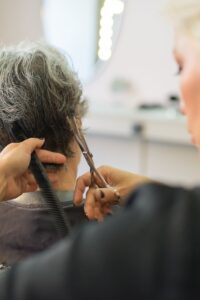Gray hair has long been linked to aging, wisdom, and the natural passage of time. While many embrace their silver strands as a symbol of maturity, others look for ways to preserve their natural hair color for a longer period. Recent scientific research indicates that lifestyle changes and habits may aid in slowing or reversing the graying process.
This comprehensive guide explores ten evidence-based habits that may help reverse gray hair naturally. Ranging from nutritional interventions to stress management techniques, these approaches target the root causes of premature graying and enhance overall hair health.
Understanding Why Hair Turns Gray
Before exploring potential solutions, it’s essential to understand what causes hair to lose its color.
Hair derives its color from melanin, a pigment produced by cells known as melanocytes located at the base of each hair follicle. As we age, these melanocytes slowly produce less melanin, leading to new hair growing lighter and eventually appearing gray or white.
Several factors can accelerate this process:
- Genetics: Your genetic makeup largely determines when you’ll start graying.
- Oxidative stress: Free radical damage can affect melanin production.
- Nutritional deficiencies: Lack of specific vitamins and minerals can impact hair pigmentation.
- Hormonal changes: Fluctuations in hormone levels can trigger premature graying.
- Chronic stress: Prolonged stress may deplete melanin-producing cells faster.
- Certain medical conditions: Autoimmune disorders and thyroid issues can affect hair color.
The good news is that some of these factors are within our control. Let’s explore habits that may address these underlying causes.
Natural Ways to Restore Your Hair Color
Habit 1: Enhance Your Nutrition with Catalase-Rich Foods
One of the leading theories about graying hair involves the buildup of hydrogen peroxide in hair follicles. Typically, our bodies produce an enzyme called catalase, which breaks down hydrogen peroxide into water and oxygen. However, as we age, catalase production decreases, allowing hydrogen peroxide to accumulate and bleach hair from the inside out.
What You Can Do:
Incorporate catalase-rich foods into your daily diet:
- Sweet potatoes
- Carrots
- Almonds
- Garlic
- Leeks
- Broccoli
- Cabbage
- Kale
- Cucumber
- Radish
A real-life example comes from Maria, a 48-year-old woman who noticed her premature graying reversing after consistently incorporating catalase-rich foods into her meals for six months. “I started having a sweet potato with lunch and adding broccoli or kale to dinner on most days,” she shared. “After about half a year, I noticed that new growth at my roots was coming in darker than before.”
Habit 2: Address Deficiencies in Vitamins and Minerals
Research has linked several nutritional deficiencies to premature graying, particularly B vitamins, vitamin D, vitamin E, iron, copper, and zinc.
What You Can Do:
Focus on incorporating these nutrients into your diet:
- Vitamin B12: Found in eggs, dairy products, meat, fish, and fortified cereals.
- Vitamin B5 (Pantothenic Acid): Available in whole grains, eggs, meat, and legumes.
- Vitamin B9 (Folate): Abundant in leafy greens, citrus fruits, beans, and whole grains.
- Vitamin D: Obtained through sun exposure and foods like fatty fish, egg yolks, and fortified products.
- Vitamin E: Present in nuts, seeds, vegetable oils, and green vegetables.
- Iron: Found in red meat, green bananas/plantains, spinach, lentils, and fortified cereals.
- Copper: Available in shellfish, nuts, seeds, and chocolate.
- Zinc: Present in oysters, red meat, poultry, beans, and nuts.
James, a 52-year-old with a history of vegetarianism, discovered that his graying was linked to a B12 deficiency. He said, “After supplementing with B12 for several months and adjusting my diet to include more B12-fortified foods, I noticed that new hair growth was coming in with more pigment.”
Habit 3: Incorporate Antioxidant-Rich Foods

Oxidative stress speeds up the aging process, including hair graying. Antioxidants neutralize free radicals that can harm melanin-producing cells.
Here’s What You Can Do:
Eat a rainbow of antioxidant-rich foods daily:
- Berries: Blueberries, strawberries, and blackberries are packed with anthocyanins.
- Dark chocolate: Contains flavonoids that fight oxidative stress.
- Green tea: Rich in polyphenols that protect cells from damage.
- Colorful vegetables: Bell peppers, spinach, and red cabbage provide various antioxidants.
- Spices: Turmeric, cinnamon, and ginger have powerful anti-inflammatory properties.
Let’s check out Jenny’s experience. She incorporated a morning smoothie with berries, spinach, and turmeric daily. “After about eight months, friends started asking if I was coloring my hair because my natural color was returning at the roots,” she said.
Habit 4: Manage Chronic Stress
Chronic stress can accelerate the aging process, including premature graying. Research suggests that stress hormones may affect the survival and activity of melanocytes.
What You Can Do:
Develop a consistent stress management routine:
- Daily meditation: Even 10 minutes can significantly reduce stress hormones.
- Regular physical activity: Exercise releases endorphins that counteract stress.
- Adequate sleep: Aim for 7-9 hours of quality sleep each night.
- Breathing exercises: Practice deep breathing for immediate stress relief.
- Nature exposure: Spending time outdoors lowers cortisol levels.
David, a high-stress executive, found that implementing a 20-minute meditation and evening walks reduced his stress levels and slowed his graying process. “After a year of consistent stress management, I noticed new hair growth was coming in darker, especially around my temples where I’d gone completely gray,” he noted.
Habit 5: Explore Specific Herbal Remedies
Several traditional herbal remedies have been used for centuries to address premature graying. While scientific evidence varies, some show promising results.
What You Can Do:
Consider incorporating these herbs:
- He Shou Wu (Fo-Ti): A Chinese herb traditionally used to restore hair color.
- Bhringraj (Eclipta alba): An Ayurvedic herb known for its hair-darkening properties.
- Amla (Indian Gooseberry): Rich in vitamin C and used in many hair-darkening formulations.
- Black sesame seeds: Contains melanin-supporting nutrients.
- Ashwagandha: Helps combat stress-induced premature graying.
These can be consumed as supplements or teas or applied topically as oils or masks.
Priya began using amla oil treatments weekly and incorporated ashwagandha into her morning routine. “Within four months, I started seeing a noticeable difference in new growth coming in darker than before,” she shared.
Habit 6: Regular Scalp Massage with Nourishing Oils
Scalp massage stimulates blood circulation to hair follicles, potentially supporting melanocyte function and nutrient delivery.
What You Can Do:
Practice scalp massage 2-3 times weekly, using beneficial oils:
- Coconut oil: Penetrates the hair shaft and nourishes follicles.
- Sesame oil: Contains tyrosine, an amino acid involved in melanin production.
- Castor oil: Rich in omega-9 fatty acids that support healthy hair growth.
- Rosemary oil: Stimulates circulation and may prevent hair loss.
- Almond oil: Provides vitamin E that protects hair follicles from oxidative stress.
Massage technique: use your fingertips (not nails) to apply gentle pressure in circular motions across your scalp for 5-10 minutes.
Michael, who began doing weekly coconut oil massages with added rosemary essential oil, reported, “After about five months of consistent treatment, I noticed the hair around my sideburns, which had gone completely gray, was growing noticeably darker.”
Habit 7: Consistent Exercise for Improved Circulation
Exercise increases blood flow throughout the body, including to hair follicles. This improved circulation delivers more nutrients and oxygen while removing waste products.
What You Can Do:
Aim for a balanced exercise routine:
- Cardiovascular exercise: 150 minutes of moderate activity weekly.
- Strength training: 2-3 sessions per week.
- Yoga: Especially inversions that increase blood flow to the scalp.
- Walking: Even 30 minutes daily improves overall circulation.
- Swimming: Provides full-body circulation benefits without joint stress.
A yoga instructor, Jovi, noticed changes after incorporating more inversions into her practice. “After about eight months of regular Downward Dog and headstand practice, along with other healthy habits, I started seeing my natural brown color returning at the roots,” she explained.
Habit 8: Stop Smoking and Cut Down on Alcohol Consumption
Multiple studies have directly linked smoking to premature graying. Smoking increases oxidative stress, reduces vitamin absorption, and constricts blood vessels that nourish hair follicles.
What You Can Do:
- Quit smoking completely
- Limit alcohol consumption to moderate levels
- Replace these habits with healthier alternatives
Bob noticed a significant change after quitting his pack-a-day habit. “About ten months after quitting smoking, not only did I feel better overall, but I noticed new hair growth was significantly darker than before,” he shared.
Habit 9: Use Natural Hair Products Free from Harsh Chemicals
Commercial hair products often contain harsh chemicals that can damage hair follicles and potentially accelerate the graying process.
What You Can Do:
Switch to natural alternatives:
- Natural shampoos: Free from sulfates, parabens, and artificial fragrances.
- DIY hair masks: Using ingredients like yogurt, egg, honey, and olive oil.
- Natural hair rinses: Apple cider vinegar or herbal infusions.
- Mineral-free water: Consider a shower filter to remove chlorine and heavy metals.
- Natural hair dyes: Choose henna or other plant-based options if coloring is necessary.
Amiratu transitioned to natural hair care products and noticed improvements within six months. “Not only did my hair become healthier overall, but I started seeing more of my natural color returning at the roots,” she reported.
Habit 10: Optimize Your Hormonal Balance
Hormonal imbalances, particularly thyroid issues, can contribute to premature graying. Supporting your endocrine system may help maintain hair color.
What You Can Do:
- Regular thyroid check-ups: Particularly if you have a family history of thyroid disorders.
- Adaptogenic herbs: Consider ashwagandha, holy basil, and rhodiola to support hormone balance.
- Healthy fat consumption: Essential for hormone production.
- Adequate protein intake: Provides the building blocks for hormones.
- Reduce endocrine disruptors: Minimize exposure to plastics, pesticides, and certain personal care ingredients.
Tom discovered his premature graying was linked to an undiagnosed thyroid condition. “After getting proper treatment and supporting my thyroid health naturally, I noticed new hair growth started coming in with more pigment after about a year,” he explained.
Combining Approaches for Optimal Outcomes

While these habits can help tackle specific causes of premature graying, the most impressive results usually stem from a comprehensive approach. Think about developing a personalized plan that addresses multiple factors at once.
For example, a well-rounded approach might include:
- A nutrient-dense diet rich in catalase, antioxidants, and essential vitamins and minerals
- Regular stress management practices
- Weekly scalp massages with beneficial oils
- Consistent physical activity
- Elimination of harmful habits like smoking
- Use of targeted herbal supplements
Many who have successfully slowed or partially reversed their graying report that consistency is key—these aren’t quick fixes but lifestyle changes that show results over months or years.
Overall: Patience and Realistic Expectations
While these habits may help slow or reverse some graying, it’s important to maintain realistic expectations. Complete reversal is rare, and results vary significantly based on individual factors, including:
- Your age
- How long you’ve been graying
- The extent of graying
- Your genetic predisposition
- Underlying health conditions
The journey to healthier, potentially less gray hair is a marathon, not a sprint. Most individuals who report success with natural methods mention that it took 6 to 12 months of consistent habits before they observed changes. It usually begins with new growth appearing darker at the roots.
Remember that gray hair is a natural part of aging for most people. While these habits may help you maintain your natural color longer or partially restore it, they also promote overall health and well-being—benefits that go far beyond hair appearance.
Whether your gray hairs retreat completely, partially, or slow their advance, the healthy habits described in this article will support your hair health, vitality, and wellness at any age. Perhaps that confidence and radiance are the most youthful attributes of all.
Have you explored any of these methods to tackle premature graying? We would love to hear about your experiences in the comments below!



4 thoughts on “10 Habits to Reverse Gray Hair and Feel Younger From Within Naturally”
Another informative article. Great read!
This was really informative. Thank you so much.
Loved hearing the success that others had with each method. I also liked how you managed expectations. So much hinges on food/nutrition and lifestyle.
Is there any way to determine which of these methods or combos will work for you before you get started?
Thanks so much, Cee! You’re right— food and lifestyle make a big difference.
There’s no one-size-fits-all, but starting simple and seeing how your body responds is a great way to figure out what works best for you!